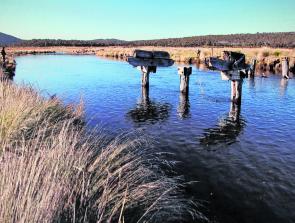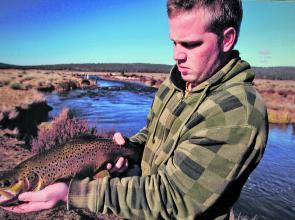After a nervous wait in early winter, anglers in the Canberra-Monaro district are now delighted with the amount of snow that has fallen on the Snowy Mountains in NSW and the Brindabella Mountains in the ACT. In the Brindabellas there was an extensive snow cover right down to the edges of some suburbs after one major fall. The main areas in the Snowies have at least 1m of snow cover and it is much deeper on the upper parts of the Main Range. The even better news is that there is a lot more to come before the end of winter.
The significance of this is that there will be plenty of runoff of sparkling clean, highly oxygenated water to the mountain trout streams and in particular to the streams the rainbow trout will use for their main spawning run in August and September. Streams should be topped up nicely, too, for the opening of the trout season on the October long weekend. Also, in the longer term, water trapped in alpine bogs will gradually be released to the open environment and that should ensure that trout streams continue to flow well into the spring and summer period. A win-win situation all round.
There will be a lot more interest in the rainbow spawning run this year than in past years. During the year the rainbows have been conspicuously absent from catches in both Jindabyne and Eucumbene and there has been fierce debate as to whether they are not there or simply too hard to catch. The spawning run will provide fisheries managers with an opportunity to place traps on the main spawning rivers, the Thredbo and Eucumbene, and gauge the numbers moving up and downstream and compare them with previous years. That should settle the argument about the rainbows’ presence or absence, but not necessarily the reasons underlying why so few have been caught.
Fish captured in the traps also will be harvested for egg and semen production to produce fry and fingerlings at Gaden Hatchery for later stocking of Jindabyne, Eucumbene and other waterways.
Few anglers have been fishing the big mountain lakes during the winter, suggesting that anglers are not as tough as they used to be. Perhaps the allure of a warm house and something interesting on TV is winning out over the joys of fishing on a crisp winter morning with a dancing big fish on the end of your line!
Catches in Jindabyne early in the winter were miserably small, with just an odd fish to show for a two to three day trip. Some anglers blanked and as the word went round about the missing rainbows even fewer anglers ventured to the area. Fishing was so quiet at one stage that it took a bait fisher on average 25 hours to catch one fish. Not an attractive catch per effort.
Later in the season, however, a few more fish began to show. Large hungry browns returning from spawning were taken on bardi grubs and scrub worms and lures such as Tasmanian Devils and Rapala minnows. Fly fishers polaroided a few nice browns with cased caddis and other small patterns. A few rainbows showed, reviving hope about their survival.
There was a similar but slightly more hopeful picture at Eucumbene. A few rainbows were taken on PowerBait and scrub worms and the pattern seemed to be for the browns to return in groups rather than singly, so the picture often was for one group of anglers to bag out with plenty of fish whilst others nearby caught nothing. Catches overall were better in Eucumbene than Jindabyne but the small number of rainbows caught was still of concern.
The brown trout spawning runs in both the Thredbo and Eucumbene rivers were deemed to be a great success. Large numbers of fish were seen and they looked to be in good health, with firm, brightly coloured bodies and strong musculature. The population in both lakes appears self-sustaining, as in previous years, and browns again will be the dominant species in the lakes next season.
It is difficult to suggest where anglers should fish during in late winter. In Jindabyne, Creel Bay would be my best suggestion, taking advantage of pre-spawning rainbows that should pass through this area. Similarly, in Eucumbene I would suggest trying Seven Gates and Yens Bay for the returning browns, and the upper reaches of Providence Flats for pre-spawning rainbows.
Tantangara Reservoir is always worth a try in winter time because of its good population of brown trout. They tend to be small, but there are plenty of them and they provide good sport, especially on fly and lure. One problem, though, is that you can easily get snowed in there in winter and it takes a long time for the snow ploughs to clear the road so you can get out. Consequently, if you venture in there, always pack extra food, water and fuel and leave as soon as a snow storm begins. Wait too long and you might be stuck there for four or five days.
Lowland lakes such as Wyangala and Burrinjuck are well worth a try in winter. The cooler temperatures quieten the resident fish but they have to feed sooner or later so if you persist you have a chance of scoring a fish.
In Wyangala some large Murray cod were taken on lures in the Lachlan River Arm. This area is not renowned as a big cod area but the anglers all used supersized lures, deeper divers from AC Invader and Custom Crafted, and these did the trick.
In Burrinjuck a lot of smallish Murray cod were caught on lure and bait in the Main Basin, especially later in the day when the sun was high up. Spinnerbaits and deep divers were the most successful. Some fish also were taken on bardi grubs and live yabbies.
Golden perch have been surprisingly active. Some of the best catches came from the flooded trees in the Murrumbidgee Arm where the fish had gathered previously during summer, but others were caught from the bank in all three arms – the Murrumbidgee, Goodradigbee and Yass. One group starred with 20 prime fish in a single afternoon, whereas most others were happy with one to three fish. The best baits were scrub worms and live yabbies. Some goldens were taken on lures, including small spinnerbaits, bibless minnows and Burrinjuck Specials.
Canberra's urban lakes have been mostly quiet, with just an occasional fish taken on bait or lure. Most are muddy following persistent rain but are still clear enough for lure fishing.
Small Murray cod have been taken on spinnerbaits but it takes a lot of casting to attract one fish. Surface lures have been a better and more exciting alternative, especially just after dark. Anglers tossing the lures out in Yerrabi, Ginninderra and Burley Griffin often have been rewarded with a giant, noisy boof, and although a hook-up is not assured it's a fun way to fish. Surface lures have a big future in Canberra, especially when we find a way of hanging the hooks to ensure a better hook-up rate.
We recently had a big build up of blue green algae in Lake Burley Griffin, and an angler fishing there became sick and nauseous about 20 minutes after he arrived. He developed a headache, stomach pains and trembling in the limbs and was driven home to recuperate. The symptoms worsened that night but then declined in following days. It appears he had ingested just a tiny amount of the algae when he bit a piece of line off when tying a knot. That tiny amount was enough to make him very ill and should serve as a warning to other anglers.
Blue green algae should more properly be referred to as cyanobacteria, its proper scientific classification. The cyanotoxin, weight for weight, is more toxic than cyanide. That should suffice to make sure anglers treat infestations of the organism with respect, and avoidance.
Reads: 1758
Golden perch are modestly active in Burrinjuck Reservoir, taking small spinnerbaits, bibless minnows, worms and yabbies.

The brown trout spawning runs in the Thredbo and Eucumbene rivers were deemed to be a great success, with large numbers of big healthy fish making their way upstream to the spawning beds.

There will be extra interest in the numbers of rainbow trout on the spawning run this year, given their seeming absence in Jindabyne and Eucumbene during the last season.




